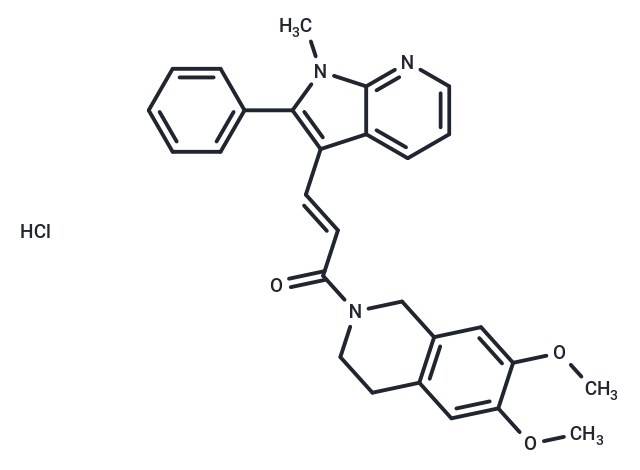Shopping Cart
Remove All Your shopping cart is currently empty
Your shopping cart is currently empty
(E)-SIS3 (SIS3) is a Smad3 inhibitor (IC50=3 μM) and is selective. (E)-SIS3 inhibits the differentiation of fibroblasts into myofibroblasts via TGF-β1.

| Pack Size | Price | USA Warehouse | Global Warehouse | Quantity |
|---|---|---|---|---|
| 1 mg | $36 | In Stock | In Stock | |
| 2 mg | $52 | In Stock | In Stock | |
| 5 mg | $113 | In Stock | In Stock | |
| 10 mg | $176 | In Stock | In Stock | |
| 25 mg | $363 | In Stock | In Stock | |
| 50 mg | $538 | In Stock | In Stock | |
| 100 mg | $768 | In Stock | In Stock | |
| 500 mg | $1,550 | - | In Stock | |
| 1 mL x 10 mM (in DMSO) | $123 | In Stock | In Stock |
| Description | (E)-SIS3 (SIS3) is a Smad3 inhibitor (IC50=3 μM) and is selective. (E)-SIS3 inhibits the differentiation of fibroblasts into myofibroblasts via TGF-β1. |
| Targets&IC50 | Smad3:3 µM. |
| In vitro | METHODS: Human dermal fibroblasts were treated with (E)-SIS3 (10 μM) for 24 hours, and the expression levels of target proteins were detected by Western Blot and Immunoprecipitation. RESULTS: (E)-SIS3 attenuated TGF-beta1-induced Smad3 phosphorylation and Smad3 / Smad4 interaction. [1] METHODS: Human dermal fibroblasts were treated with (E)-SIS3 (0.1-50 μM) for 30 minutes, and the expression levels of target proteins were detected by Western Blot. RESULTS: (E)-SIS3 significantly inhibited the expression of FN and α-SMA, but not the expression of Sphk2 induced by TGF-β1. [2] METHODS: Human dermal fibroblasts were treated with (E)-SIS3 (10 μM) for 24 hours, and the expression levels of target proteins were detected by Western Blot. RESULTS: (E)-SIS3 significantly decreased the expression of α-SMA and Palladin in primary human dermal fibroblasts. [3] |
| In vivo | SIS3 inhibits Smad3 activation in streptozotocin(STZ)-induced diabetic nephropathy in Tie2-Cre;Loxp-EGFP mice. It also reduces AGE-induced EndoMT and decreases EndoMT in STZ-induced diabetic nephropathy in Tie2-Cre;Loxp-EGFP mice. SIS3 significantly reduces collagen IV and fibronectin expression in the glomeruli and tubulointerstitium of STZ-injected Tie2-Cre;Loxp-EGFP mice, suggesting that SIS3 retards the early development of STZ-induced diabetic glomerulosclerosis and tubulointerstitial fibrosis. However, SIS3 administration does not reduce proteinuria[2]. |
| Cell Research | Normal human dermal fibroblasts are plated at a density of 105 cells/well in six-well culture plates and grown until subconfluence in MEM containing 10% FCS. Cells are quiesced by 24-h incubation in serum-free MEM, followed by incubation in serum-free medium in the presence or absence of SIS3 before the collection of cells for 72 h. Then, the cells are detached from the wells by trypsin treatment and counted using a Coulter counter.(Only for Reference) |
| Synonyms | SIS3 hydrobromide, SIS3 HCl |
| Molecular Weight | 489.99 |
| Formula | C28H27N3O3·HCl |
| Cas No. | 521984-48-5 |
| Smiles | Cl.COc1cc2CCN(Cc2cc1OC)C(=O)\C=C\c1c(-c2ccccc2)n(C)c2ncccc12 |
| Relative Density. | no data available |
| Color | Yellow |
| Appearance | Solid |
| Storage | Powder: -20°C for 3 years | In solvent: -80°C for 1 year | Shipping with blue ice/Shipping at ambient temperature. | ||||||||||||||||||||||||||||||||||||||||
| Solubility Information | Ethanol: 23 mg/mL (46.94 mM), Sonication is recommended. H2O: < 1 mg/mL (insoluble or slightly soluble) DMSO: 100 mg/mL (204.09 mM), Sonication and heating are recommended. | ||||||||||||||||||||||||||||||||||||||||
| In Vivo Formulation | 10% DMSO+40% PEG300+5% Tween 80+45% Saline: 3.3 mg/mL (6.73 mM), Sonication is recommended. Please add the solvents sequentially, clarifying the solution as much as possible before adding the next one. Dissolve by heating and/or sonication if necessary. Working solution is recommended to be prepared and used immediately. The formulation provided above is for reference purposes only. In vivo formulations may vary and should be modified based on specific experimental conditions. | ||||||||||||||||||||||||||||||||||||||||
Solution Preparation Table | |||||||||||||||||||||||||||||||||||||||||
Ethanol/DMSO
DMSO
| |||||||||||||||||||||||||||||||||||||||||
| Size | Quantity | Unit Price | Amount | Operation |
|---|

Copyright © 2015-2026 TargetMol Chemicals Inc. All Rights Reserved.